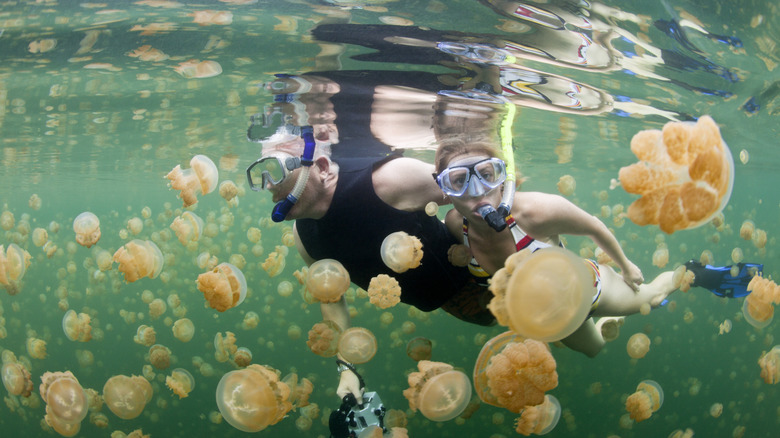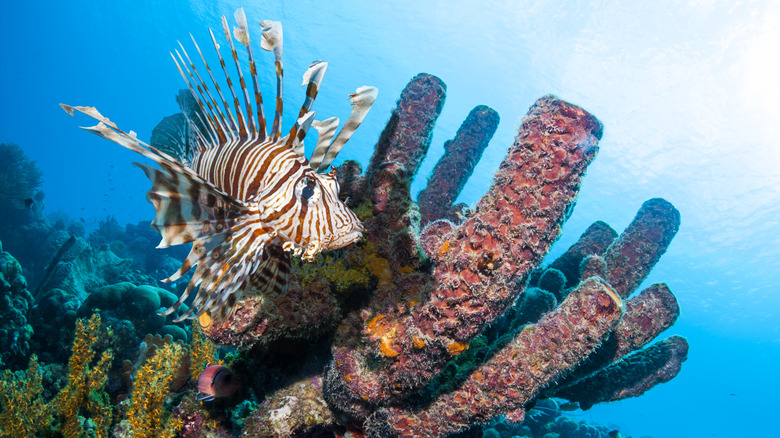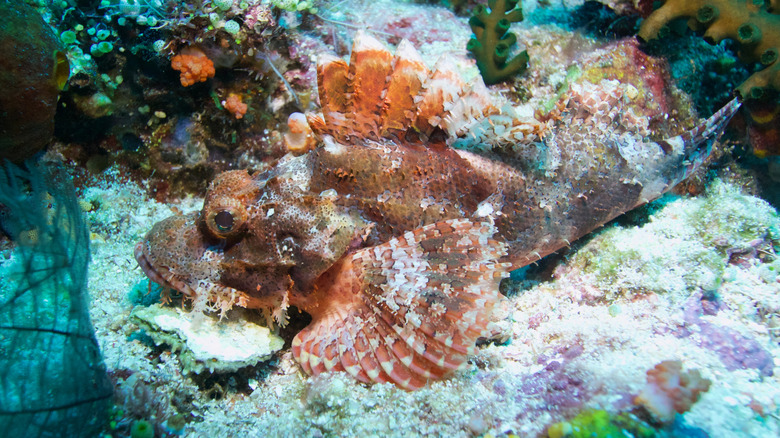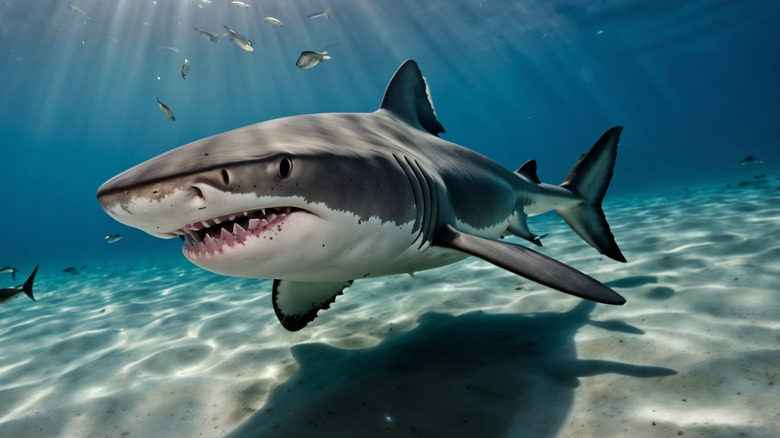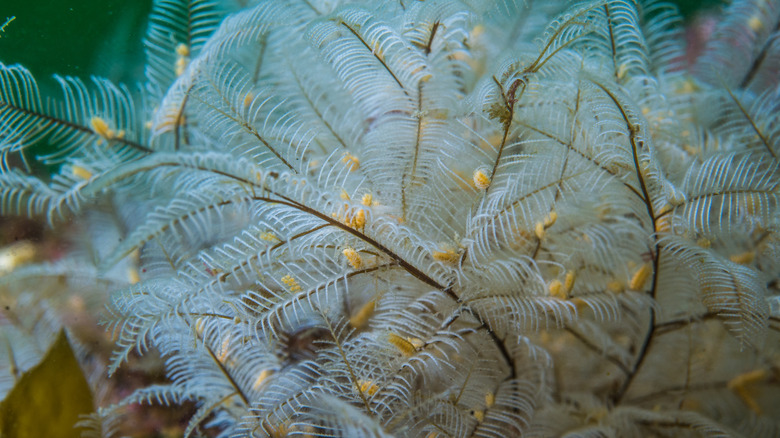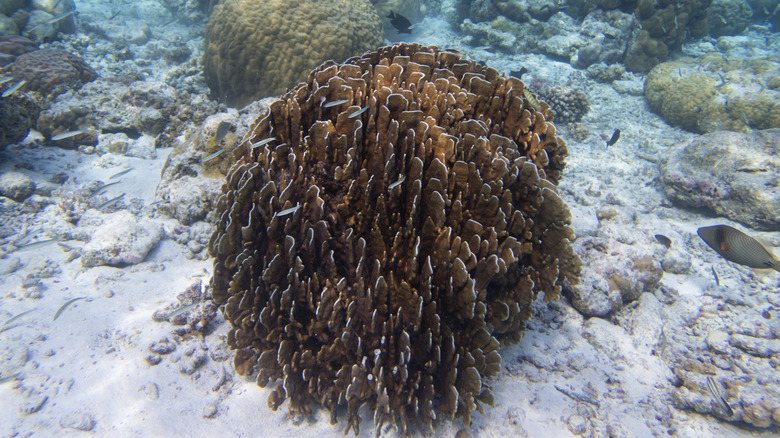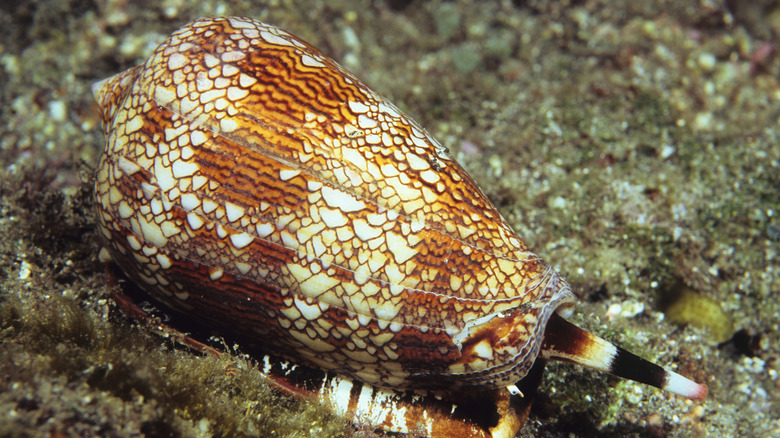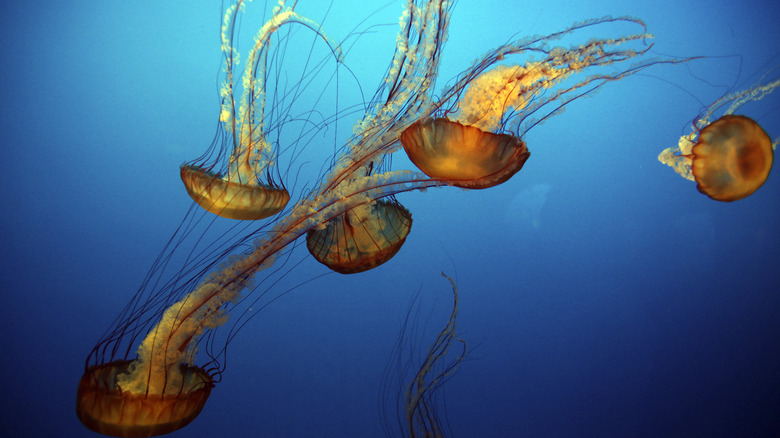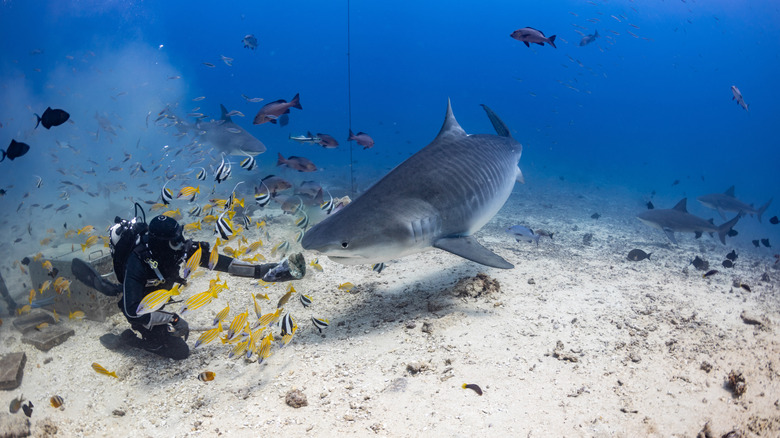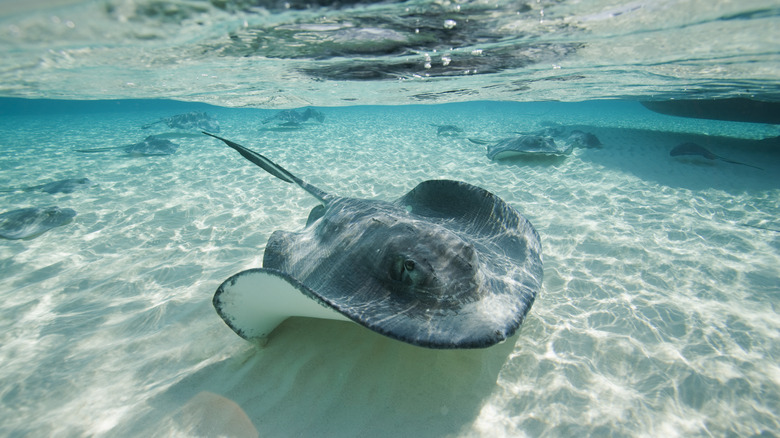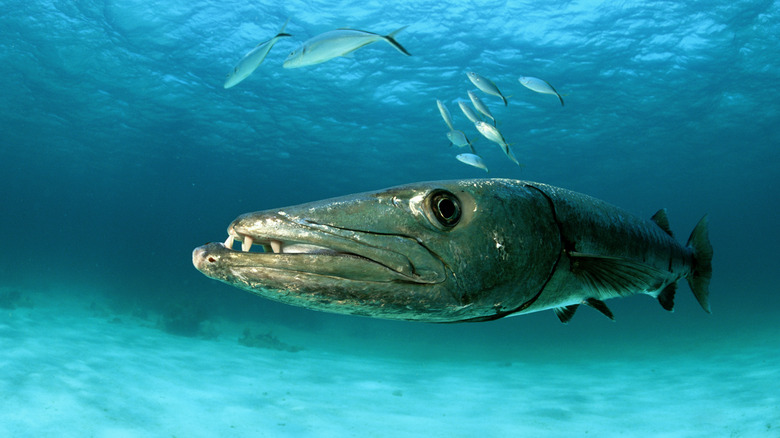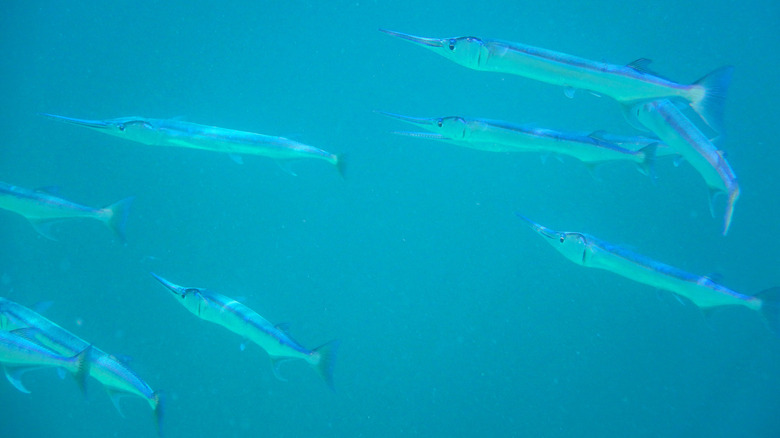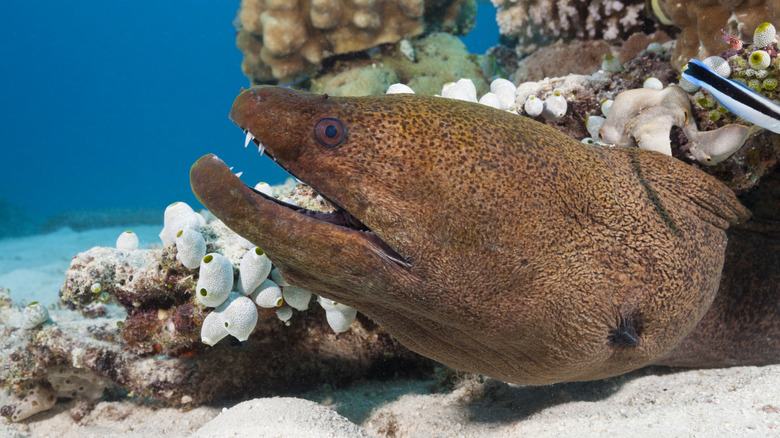12 Dangerous Creatures To Be Aware Of Before Snorkeling In The Caribbean
We may receive a commission on purchases made from links.
Scuba diving like a professional can take a lot of skill, but there's one thing you should always consider when plunging into the depths with your underwater camera: what's going to be down there with you? The stunning Caribbean Sea covers over 2.75 million square kilometers, and at its deepest point reaches down over 25,200 feet. Its sheer vastness and warm climate make it a bucket-list destination for divers looking to stretch their fins but be warned. Whether you're a scuba diving pro or a snorkeling tourist looking to get a peep at life under the sea, there are some dangerous critters down there that may not take kindly to visitors.
In some cases, dangers can be disguised as pretty plants, waiting for unsuspecting bikini-clad swimmers to reach out a hand and touch them. Other snorkelers may find themselves in terrible pain after a run-in with a beautiful but deadly fish, or accidentally stand on something that gives them a nasty surprise. We're not saying avoid this wonderful activity altogether, but when it comes to taking a dip, knowledge is everything. We've trawled the depths to create a comprehensive round-up of what creatures to avoid when you hit the water, and why.
Lionfish
Knowing how to safely snorkel around coral reefs is imperative for any beginner, and it's a beloved vacation activity for a reason. Reefs are hives of activity, with many beautiful fish flitting in and out of the rocks and plants. Lionfish are commonly spotted in the Caribbean Sea and are noteworthy for many reasons. They are visually striking fish, with lion-like stripes, frilly fins, and a blunt face. While they're lovely to observe from afar, don't be fooled by their interesting appearance. Their pretty fins are actually venomous spikes that act as part of their defense system, delivering a painful and nasty sting to any predator (or unsuspecting snorkeler) that may dare to touch them.
This isn't just any regular sting, either. Symptoms include difficulty breathing, intense sweating, and even convulsions, which will soon put an end to your entire vacation. Swelling can also become a major issue if not treated properly, becoming a threat to blood supply. If you spot one of these little guys while you're taking a dip, it's best to head in the other direction and hope it doesn't follow you. Small but deadly has never been a truer description!
Stonefish
Sometimes, it's the things that you don't spot that can do the most damage. Stonefish, believe it or not, can be mistaken for a rock at first glance, making them easy to overlook and, in turn, doing well to protect them from predators. While this ingenious talent is a bioengineering marvel, it's a swimmer's worst nightmare. Stonefish have spines on their backs that can pack a devastating punch. Though they may look unthreatening at first, these little spines stiffen when the fish begins to feel threatened, by another fish, or someone swimming by a little too closely. Stonefish are one of the most venomous creatures living in our oceans.
A sting from a stonefish isn't just incredibly painful, it can be fatal. Just like a bite from a deadly snake, the victim needs to receive anti-venom straight away to survive. If medical treatment isn't sought, then it can be game over in just an hour. In short, do your research and be sure that you're familiar with the appearance of this undercover death trap. Thankfully, stonefish don't typically attack for no reason. They lay in wait for prey rather than seeking it out, but if you accidentally step on one, all bets are off.
Great White sharks
Anyone who's ever dipped a toe in exotic waters has probably considered the possibility of sharks. After all, "Jaws" was a hit for a reason. Great White sharks are deadly creatures known to attack humans, usually mistaking them for seals or other food. Shark bites can be devastating, resulting in heavy scarring and often the loss of limbs — if you manage to survive. Though running into a Great White shark is unusual, it can happen as they are known to love the temperature of the waters in the Caribbean Sea. If you find yourself face to face with its harrowing jagged smile, there are a couple of things you can do to try and divert it. Keeping calm is essential, which isn't always the easiest thing to do in this life-or-death situation.
"If a shark approaches, redirect the shark by firmly placing your hand on its snout and pushing in a direction away from you," wrote one Redditor, a marine biologist. As well as paying attention to this advice, it's worth considering other factors, such as the time of day you snorkel and swim, and avoiding areas with poor visibility when the sun sets. If the worst does happen, you can protect yourself further by aiming for weak spots such as the eyes and gills.
Stinging hydroids
To the untrained eye, these underwater organisms look incredibly alluring, like feathery plants begging to be stroked. Howing, stinging hydroids aren't something you want to come into contact with, no matter how pretty they may look. Like many beautiful but deadly things lurking under the surface of the Caribbean Sea, stinging hydroids are harmful to humans. However, they aren't fatal. "Just a brief contact with these organisms can give a painful red, itchy rash that can last for weeks and can produce pustules that can break and become infected," marine biologist Dr. Richard Smith told Scuba Diving.
While you'll get a horrible rash, you don't have to worry about any fatal symptoms and you may not even need to seek professional help. Wash the area with soap and water and rinse it thoroughly to alleviate the pain. A vinegar wash can also help, but if symptoms persist getting some hydrocortisone cream over the counter and doubling down with a good dosing of calamine lotion may do the trick. Of course, prevention is the best treatment, so staying vigilant when snorkeling near reefs will go a long way.
Fire coral
Some of the most stunning snorkeling destinations are also home to fire coral. It's undeniably beautiful, like most coral found in the Caribbean Sea and beyond, with fascinating colors and an interesting shape. But, several things make fire coral particularly dangerous to snorkelers and swimmers, so take heed. Uneducated divers have mistaken it for seaweed due to its yellow, green, and brown tint, but it's nowhere near as friendly. Coming into contact with fire coral can cause an ongoing burning, fiery sensation that can last from a couple of days to several weeks. It can also calcify and harden depending on location, leading to open cuts if divers aren't careful.
These sorts of injuries are usually the nastiest, as the wound can become necrotic. Sure, it's not deadly, but trust us — fire coral isn't something you want to stumble onto (or into) when you're having a relaxing vacation. Thankfully, treatment is relatively simple. Store cupboard vinegar can do the trick, as will keeping the sting dry and clean. Be warned, it may look pretty nasty, with blisters appearing. Whatever you do, resist the urge to pop them and let the sting dry up on its own to avoid complications.
Cone snails
Land snails are typically sweet, slow creatures we often find cute and non-threatening — unless they're eating our flowers, of course. When you dive into the Caribbean Sea, that changes somewhat. Cone snails are striking because of their ornate, beautiful shells, but they are ready and willing to defend themselves against anything that may harm them. With over 600 species, some cone snails can be hard to identify, but they all have one thing in common: a sharp tooth that can shoot out and inject its prey with a neurotoxin. Needless to say, winding up on the wrong side of one can be a huge downer.
Cone snails are particularly harmful to snorkelers because they live in shallow environments, such as reefs. There is an upside, though. Unlike some of the other underwater criminals in the Caribbean Sea, cone snails won't hurt humans unless they are disturbed. Whatever you do, don't be fooled by its alluring pretty shell. Leave them well alone, don't pick them up, and don't stand on them, and you'll be fine. In rare cases, cone snail stings can cause paralysis, but this depends on several factors such as the type of species encountered.
Box jellyfish
You don't have to be an avid snorkeler to know that coming face-to-face with a jellyfish can turn your great day into a terrible one at a moment's notice. Box jellyfish are stunning creatures that are truly mesmerizing to watch, but it's common knowledge that their stings can cause a lot of pain. They can be found in the Caribbean Sea, so if you're intent on this destination then it's important to take some factors into consideration first. While the severity of their sting depends on what species it is, some are known to prove fatal.
They have some interesting features, with some having up to 24 eyes which helps them to locate small fish to feed on. Given the incredibly short time it takes to fall victim to stings from some of these critters (less than three minutes in certain cases), they must avoided. To be certain, talk to local guides about the area you plan to snorkel in before you head into the water and follow their advice. If you happen to be stung by any jellyfish, you should call for help immediately and drench the sting in household vinegar. Having a hot bath can also help the pain.
Tiger sharks
The Caribbean is home to one of the most dangerous shark-infested beaches in the world. Even if you don't plan on visiting West End in the Grand Bahamas, beware of tiger sharks in particular. In 2022, a man died after one of the stealthy predators attacked him when he swam on the Colombian island of La Piscinita. The victim, a 56-year-old Italian man named Antonio Straccialini, came into contact with one of the sharks and was severely bitten. Though he managed to make it out of the water, the shock and loss of blood were too much for his body to bear. Interestingly, this particular destination is a mecca for snorkeling, which just goes to show how cautious you have to be when in the water.
Though this was a rare occurrence and the first time a tiger shark had fatally attacked a tourist, it served as a stark warning to both locals and visitors alike. When you enter the water, you are no longer at the top of the food chain. Tiger sharks can swim at 20 miles an hour, leaving swimmers little chance of getting out of the water in time in a tricky situation. What's more, they can grow to extremely large sizes, with some even reaching 14 feet.
Stingrays
Stingrays are one of the top hidden dangers of swimming in the Caribbean Sea. These otherworldly creatures are a wonder to observe, with their distinctive flat bodies moving smoothly through the water. It's not hard to see why swimmers love to see them, or why they're such a popular attraction at aquariums. Stingrays are commonplace in this ocean, with many companies specializing in taking tourists out to see them. If you happen to spot one of these while snorkeling, it's best to keep your distance and observe from afar. While they aren't vicious, they will defend themselves if they feel threatened, which can be painful — and in some cases, catastrophic.
Though they may not be the fastest fish in the sea, stingrays have an impressive built-in defense mechanism. Their long barbed tails can whip around and deliver a powerful cut and sting at the same time. Some wounds can be shallow while others can be much nastier, and in some cases, fatal. Television personality Steve Irwin famously died in 2006 after a stingray barb struck him in the chest, leading to cardiac arrest. While situations like this are rare, it's highly recommended that snorkelers and swimmers shuffle their feet along the seabed as they enter the water to force any stingrays in the sand to scatter.
Barracuda
Unlike some of the other sea life in the Caribbean Sea, barracuda aren't particularly pleasant to look at. They look as though they would be well-suited to prehistoric living, with their long faces and strong teeth. Barracuda are commonly found in several different oceans, from the Pacific to the Mediterranean, so it's quite likely that you may spot one if you hang around long enough. These large critters won't swim around looking for a human to attack, as they much prefer swallowing their meals whole. However, as with any animal on land or in water, barracuda will defend themselves if they feel there's a threat present.
According to one marine biologist on Reddit, it's best to avoid pursuing them if you spot one and to leave any shiny jewelry or accessories on land. Barracuda recognize potential food by looking for reflective scales, and they may mistake a glint of silver or gold for their next meal and gravitate towards you as a result. Follow these rules and you'll have a great snorkeling experience without having to seek medical attention at the end of it!
Needlefish
At first glance, it may seem like spotting needlefish as they glide through the water is everything a snorkeler could dream of. They're beautiful, agile, and seemingly harmless to those with little knowledge of sea life. Unfortunately, these slippery guys can cause devastating damage if they put their mind to it. Commonly found in the Caribbean Sea, needlefish can do exactly what it says on the tin (pardon the pun.) Their long and thin jaws can inflict serious pain and even death. Though it didn't happen in this locality, a 36-year-old surfer lost her life in 2024 after a suspected needlefish stabbed her in the chest when she was enjoying the water in Indonesia.
Needlefish are long, giving them the ability to leap out of the water and attack. They're often in a rush and have been known to leap over small boats to get to the other side in a hurry, creating a menacing risk for snorkelers or swimmers taking a break onboard. If you do happen to pick up an injury from a needlefish, get medical attention as soon as possible, as antibiotics may be required to stave off infection. On the bright side, needlefish don't usually attack humans for no reason, so as long as you respect them and their habitat, and stay aware, you shouldn't have anything to worry about.
Moray Eels
There's no denying that Moray eels aren't particularly attractive creatures, with their thick bodies and stumpy jaws. With that being said, there's something about them that feels almost alien, which is enticing within itself. There's also something to be said for their behavior. You won't catch a Moray eel going out of its way to find a meal, as they much prefer when the food is delivered to them. They typically lurk on the sea bed, waiting for small fish to come close enough for them to grab. If the prey is on the larger side, they wrap their bodies around it to stop them from escaping, before going in with their small but incredibly sharp teeth.
Moray eels largely fall into the category of "don't mess with them and they won't mess with you." That's not to say they don't present a very real danger, though. They have two sets of jaws and their mucus contains unpleasant toxins that can be harmful. One user on the Scuba Board forum recalled an encounter they witnessed. "[The eel] was poking around in the coral, and suddenly a high-speed lobster blasted out. The moray tried for the lobster, missed, and bit the woman. She didn't even see it — at first, she thought someone had kicked her," they explained. Top tips to avoid irking an eel include giving them somewhat of a wide berth and not putting your face or hands into dark spots in coral reefs.
